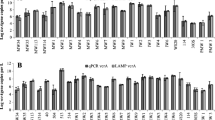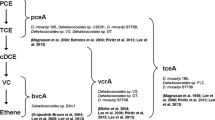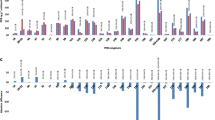Abstract
The unique capacity of Dehalococcoides ethenogenes of completely dechlorinating the common groundwater pollutant tetrachloroethene (PCE) to the harmless ethene makes this microorganism very attractive for application in natural or engineered bioremediation systems. In this study, the qualitative and quantitative determination of Dehalococcoides spp. in a lab-scale bioreactor was performed based on the combination of fluorescent in situ hybridisation (FISH) for specific detection, and kinetic batch tests at non-limiting hydrogen and PCE concentration for quantitative determination. The dechlorinating bioreactor was operated at a high and constant PCE loading rate of 255 μmol PCE [g volatile suspended solids (VSS)]−1 day−1. Pale coccoid cells resembling the distinctive morphotype of D. ethenogenes were present in the microbial culture. These cocci hybridised with both eubacterial probes and the Dhe1259t probe recently designed for detecting Dehalococcoides spp. Positive hybridisation was also observed when the DHC1377 reverse primer was used as a specific probe and applied to the dechlorinating microbial consortium. The maximum dechlorination rate obtained under non-limiting hydrogen and PCE concentrations was 3.22 ± 0.08 mmol Cl− l−1 day−1. From the specific activity of D. ethenogenes [i.e. 0.055 ± 0.008 mmol Cl− (mg VSS)−1 day−1], as reported from pure culture study, this observed maximum rate corresponded to a concentration of this bacterium in the mixed liquor of the bioreactor of 59.0±10.4 mg VSS·l−1 (41.5±11.2% of overall VSS). This calculated relative abundance of D. ethenogenes was in agreement with the percentage of methanol (in terms of reducing equivalents) channeled to reductive dechlorination (approximately 30%) supporting the assumption that most reductive dechlorination was actually due to this microorganism.




Similar content being viewed by others
References
Amann RI (1995) In situ identification of microorganims by whole cell hybridization with rRNA-targeted nucleic acid probes. In: Akkermans AD, van Elsas JD, de Bruijn FJ (eds) Molecular microbial ecology manual. Kluwer, London, pp 3.3.6/1–3.3.6/15
Amann RI, Binder BJ, Olson RJ, Chisholm SW, Devereux R, Stahl DA (1990) Combination of 16S rRNA-targeted oligonucleotide probes with flow cytometry for analyzing mixed microbial populations. Appl Environ Microbiol 56:1919–1925
APHA (1989) Standard methods for examination of water and wastewater, 17th edn. American Public Health Association, Washington D.C.
Aulenta F, Majone M, Di Pinto AC, Tomei MC, Tandoi V (2001) Reductive dechlorination of perchloroethene to ethene by microbial consortia in sediments. In: Proceedings of the 9th World Congress on Anaerobic Digestion, vol 2. Antwerpen, pp 239–244
Aulenta F, Majone M, Verbo P, Tandoi V (2002) Complete dechlorination of tetrachloroethene to ethene in presence of methanogenesis and acetogenesis by an anaerobic sediment microcosm. Biodegradation 13:411–424
Balch WE, Fox GE, Magrum LJ, Woese CR, Wolfe RS (1979) Methanogens: reevaluation of a unique biological group. Microb Rev 43:260–296
Ballapragada BS, Stensel DH, Puhakka JA, Ferguson JF (1997) Effect of hydrogen on reductive dechlorination of chlorinated ethenes. Environ Sci Technol 31:1728–1734
Carter SR, Jewell WJ (1993) Biotransformation of tetrachloroethylene by anaerobic attached-films at low temperatures. Water Res 4:607–615
Daims H, Bruhl A, Amann R, Schleiferm KH, Wagner M (1999) The domain-specific probe EUB338 is insufficient for the detection of all bacteria: development and evaluation of a more comprehensive probe set. Syst Appl Microbiol 22:434–444
De Bruin WP, Kotterman JJ, Posthumus MA, Schraa G, Zehnder AJB (1992) Complete biological reductive transformation of tetrachloroethene to ethane. Appl Environ Microbiol 58:1996–2000
DiStefano TD, Gossett JM, Zinder SH (1991) Reductive dechlorination of high concentration of tetrachloroethene to ethene by an anaerobic enrichment culture in the absence of methanogenesis. Appl Environ Microbiol 57:2287–2292
DiStefano TD, Gossett JM, Zinder SH (1992) Hydrogen as an electron donor for dechlorination of tetrachloroethene by an anaerobic mixed culture. Appl Environ Microbiol 58:3622–3629
Ellis DE, Lutz EJ, Odom JM, Buchanan RJ Jr, Bartlett CL, Lee MD, Harkness MR, DeWeerd KA (2000) Bioaugmentation for accelerated in situ anaerobic bioremediation. Environ Sci Technol 34:2254–2260
Fennel DE, Carroll AB, Gossett JM, Zinder SH (2001) Assessment of indigenous reductive dechlorinating potential at a TCE-contaminated site using microcosms, polymerase chain reaction analysis, and site data. Environ Sci Technol 35:1830–1839
Flynn SJ, Loeffler J, Tiedje JM (2000) Microbial community changes associated with a shift from reductive dechlorination of PCE to reductive dechlorination of cis-DCE and VC. Environ Sci Technol 34:1056–1061
Freedman D, Gossett JM (1989) Biological reductive dechlorination of tetrachloroethylene and trichloroethylene under methanogenic conditions. Appl Environ Microbiol 55:2144–2151
Gao J, Skeen RS, Hooker BS, Quesenberry RD (1997) Effect of several electron donors on tetrachloroethylene dechlorination in anaerobic soil microcosms. Water Res 31:2479–2486
Gossett JM (1987) Measurement of Henry’s law constants for C1 and C2 chlorinated hydrocarbons. Environ Sci Technol 21:202–208
Haston ZC, McCarty PL (1999) Chlorinated ethene half-velocity coefficients (K s) for reductive dehalogenation. Environ Sci Technol 33:223–226
Hendrickson ER, Payne JA, Young RM, Starr MG, Perry MP, Fahnestock S, Ellis DE, Ebersole RC (2002) Molecular analysis of Dehalococcoides 16S ribosomal DNA from chloroethene-contaminated sites throughout North America and Europe. Appl Environ Microbiol 68:485–495
Komatsu T, Shinmyo J, Momonoi K (1997) Reductive transformation of tetrachloroethylene to ethylene and ethane by an anaerobic filter. Water Sci Technol 36:125–132
Major DW, McMaster ML, Cox EE, Edwards EA, Dworatzek SM, Hendrickson ER, Starr MG, Payne JA, Buonamici LW (2002) Field demonstration of successful bioaugmentation to achieve dechlorination of tetrachloroethene to ethene. Environ Sci Technol 36:5106–5116
Maymò-Gatell X, Tandoi V, Gosset JM, Zinder SH (1995) Characterisation of an H2-utilizing anaerobic enrichment culture that reductively dechlorinates tetrachloroethene to vinyl chloride and ethene in complete absence of methanogenesis and acetogenesis. Appl Environ Microbiol 61:3928–3933
Maymò-Gatell X, Chien YT, Gosset JM, Zinder SH (1997) Isolation of a bacterium that reductively dechlorinates tetrachloroethene to ethene. Science 276:1568–1571
Middeldorp PJM, Luijten MLGC, van de Pas BA, van Eekert MHA, Kengen SWM, Schraa G, Stams AJM (1999) Anaerobic microbial reductive dehalogenation of chlorinated ethenes. Bioremed J 3:151–169
Mueller J, Meshulam-Simon G, Spormann A (2002) Anaerobic degradation of vinyl chloride. Proceedings of the Stanford microbiology symposium, October 2002
Richardson RE, Bhupathiraju VK, Song DL, Goulet TA, Alvarez-Cohen L (2002) Phylogenetic characterization of microbial communities that reductively dechlorinate TCE based upon a combination of molecular techniques. Environ Sci Technol 36:2652–2662
Rossetti S, Blackall LL, Majone M, Hugenholtz P, Plumb JJ, Tandoi V (2003) Kinetic and molecular characterization of an anaerobic dechlorinating microbial community. Microbiology 149:459–469
Schlötelburg C, von Wintzingerode C, Hauck R, von Wintzingerode F, Hegemann W, Göbel UB (2002) Microbial structure of an anaerobic bioreactor population that continuously dechlorinates 1,2-dichloropropane. FEMS Microb Ecol 39:229–237
Smatlak CR, Gosset JM, Zinder SH (1996) Comparative kinetics of hydrogen utilization for reductive dechlorination of tetrachloroethene and methanogenesis in an anaerobic enrichment culture. Environ Sci Technol 30:2850–2858
Tandoi V, DiStefano TD, Bowser PA, Gossett JM, Zinder SH (1994) Reductive dehalogenation of chlorinated ethenes and halogenated ethanes by a high-rate anaerobic enrichment culture. Environ Sci Technol 28:973–979
Vogel TM, Criddle CS, McCarty PL (1987) Transformation of alogenated aliphatic compounds. Environ Sci Technol 21:722–736
Yang Y, Zeyer J (2003) Specific Detection of Dehalococcoides species by fluorescence in situ hybridization with 16S rRNA-targeted oligonucleotide probes. Appl Environ Microbiol 69:2879–2883
Zeikus JG (1977) The biology of methanogenic bacteria. Bacteriol Rev 41:514–541
Acknowledgements
This research was financially supported by the Ministero dell’Ambiente e della Tutela del Territorio (PR.3.29/URM) and the National Research Council, CNR (Gruppo Nazionale per la Difesa dai Rischi Chimico Industriale Ecologici, GNDRCIE). We are grateful to Giancarlo Minervini, who performed the kinetic experiments, and to Franco Duranti for technical assistance.
Author information
Authors and Affiliations
Corresponding author
Rights and permissions
About this article
Cite this article
Aulenta, F., Rossetti, S., Majone, M. et al. Detection and quantitative estimation of Dehalococcoides spp. in a dechlorinating bioreactor by a combination of fluorescent in situ hybridisation (FISH) and kinetic analysis. Appl Microbiol Biotechnol 64, 206–212 (2004). https://doi.org/10.1007/s00253-003-1503-4
Received:
Revised:
Accepted:
Published:
Issue Date:
DOI: https://doi.org/10.1007/s00253-003-1503-4




